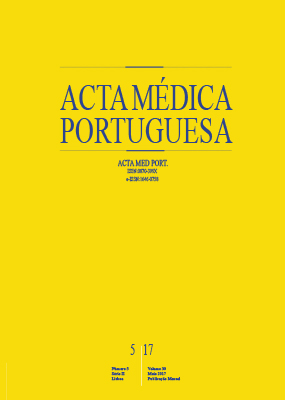Virtual Reality Simulation as a Tool to Monitor Surgical Performance Indicators: VIRESI Observational Study
DOI:
https://doi.org/10.20344/amp.7983Keywords:
Anastomosis, Surgical, Laparoscopy/education, Portugal, Simulation TrainingAbstract
Introduction: Virtual reality simulation is a topic of discussion as a complementary tool to traditional laparoscopic surgical training in the operating room. However, it is unclear whether virtual reality training can have an impact on the surgical performance of advanced laparoscopic procedures. Our objective was to assess the ability of the virtual reality simulator LAP Mentor to identify and quantify changes in surgical performance indicators, after LAP Mentor training for digestive anastomosis.
Material and Methods: Twelve surgeons from Centro Hospitalar de São João in Porto (Portugal) performed two sessions of advanced task 5: anastomosis in LAP Mentor, before and after completing the tutorial, and were evaluated on 34 surgical performance indicators.
Results: The results show that six surgical performance indicators significantly changed after LAP Mentor training. The surgeons performed the task significantly faster as the median ‘total time’ significantly reduced (p < 0.05) from 759.5 to 523.5 seconds. Significant decreases (p < 0.05) were also found in median ‘total needle loading time’ (303.3 to 107.8 seconds), ‘average needle loading time’ (38.5 to 31.0 seconds), ‘number of passages in which the needle passed precisely through the entrance dots’ (2.5 to 1.0), ‘time the needle was held outside the visible field’ (20.9 to 2.4 seconds), and ‘total time the needle-holders’ ends are kept outside the predefined operative field’ (88.2 to 49.6 seconds).
Discussion: This study raises the possibility of using virtual reality training simulation as a benchmark tool to assess the surgical performance of Portuguese surgeons.
Conclusion: LAP Mentor is able to identify variations in surgical performance indicators of digestive anastomosis.
Downloads
Downloads
Published
How to Cite
Issue
Section
License
All the articles published in the AMP are open access and comply with the requirements of funding agencies or academic institutions. The AMP is governed by the terms of the Creative Commons ‘Attribution – Non-Commercial Use - (CC-BY-NC)’ license, regarding the use by third parties.
It is the author’s responsibility to obtain approval for the reproduction of figures, tables, etc. from other publications.
Upon acceptance of an article for publication, the authors will be asked to complete the ICMJE “Copyright Liability and Copyright Sharing Statement “(http://www.actamedicaportuguesa.com/info/AMP-NormasPublicacao.pdf) and the “Declaration of Potential Conflicts of Interest” (http:// www.icmje.org/conflicts-of-interest). An e-mail will be sent to the corresponding author to acknowledge receipt of the manuscript.
After publication, the authors are authorised to make their articles available in repositories of their institutions of origin, as long as they always mention where they were published and according to the Creative Commons license.









